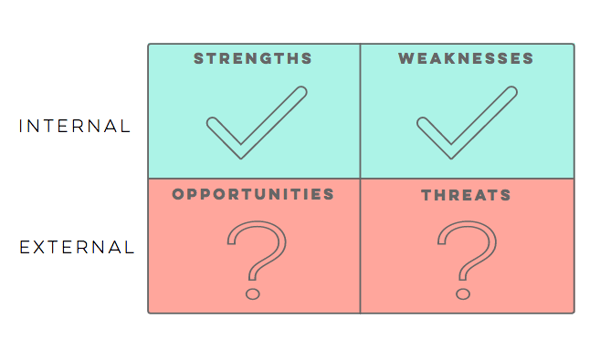So, you’re getting ready to conduct a SWOT analysis — fantastic! Whether you’re a marketer, an executive leader, a competitive intelligence (CI) professional, or someone else entirely, you’re on your way to making smarter and more impactful decisions.
As you know, conducting a SWOT analysis means evaluating your business through four distinct (yet closely connected) lenses: strengths, weaknesses, opportunities, and threats. Pretty self-explanatory, right?
Right. With that being said, determining what to include within each category of your SWOT analysis isn’t always intuitive. And that makes sense — conducting a SWOT analysis is, after all, an inherently introspective process. If introspection were easy … nevermind.

My point is that it’s difficult to be self-reflective. So, to guide you through your first SWOT analysis, we’ve compiled a collection of two dozen SWOT analysis questions — questions you’ll want to carefully consider in order to set yourself up for success going forward.
We’ll begin with some relatively broad SWOT analysis questions to get you thinking about your business and your competitive landscape. Then, because we here at Crayon are committed to helping you stay a step (or three) ahead of your rivals, we’ll share the questions you need to address in order to determine where you stand in relation to your closest direct competitor.
Ready to get started? Download your free competitive analysis template
12 SWOT Analysis Questions: Your Business & Your Market
Important note: You don’t necessarily need to answer each of these questions individually. The purpose of this blog post is simply to get you thinking — to unlock the in-depth knowledge you already possess with respect to your strengths, weaknesses, opportunities, and threats.
By no means exhaustive, here are 12 SWOT analysis questions to get your wheels turning.
Strengths
- What value do you provide that can’t be replicated by anyone else in the market?
- Why do customers give you their business? What keeps them coming back?
- What are you most proud of? What are your employees and/or coworkers most proud of?
Weaknesses
- What are some of the internal forces cutting into your bottom line?
- Why did former customers churn? What drove them away?
- What’s holding you back from accomplishing the things you want and/or need to accomplish?
Opportunities
- Can you satisfy any unmet demands that have been vocalized by your target customers?
- Are there any emerging technologies that you can use to your advantage?
- How can you apply your existing strengths in new and/or innovative ways?
Threats
- What are some of the external forces cutting into your bottom line?
- Are there any emerging technologies that undermine the perceived value of your business?
- In what ways might your weaknesses get exposed or exploited?
12 SWOT Analysis Questions: Your Closest Direct Competitor
Hopefully, after working through our first batch of SWOT analysis questions — along with any others you came up with along the way — you’ve got a strong sense of where your business stands in the context of your market.
The time has come, now, to turn your attention to something more specific (and, perhaps, more exciting): your closest direct competitor. (A direct competitor, for anyone unfamiliar with the term, is a rival business with which you compete head-to-head for revenue.) Those of you in particularly crowded markets likely have several direct competitors that are each of equal importance. For the sake of simplicity, the following SWOT analysis questions have been written under the assumption that you’re thinking about one competitor in particular.
Again, keep in mind that the sole purpose of this non-exhaustive list is to get you thinking!
Strengths
- What are your key differentiators? In what ways is your product or service superior?
- Why, specifically, do some customers choose to do business with you rather than them?
- What’s your gut reaction when asked for a comparison between your business and theirs?
Weaknesses
- What about your competitor’s business keeps you up at night?
- Why, specifically, do some folks choose to do business with them rather than you?
- Are you unable to replicate some of the ways in which they provide value to customers?
Opportunities
- Are there unmet demands in the market that you — and only you — can satisfy?
- Can you use an emerging technology to amplify your strengths or exploit their weaknesses?
- How might you more effectively communicate the ways in which you’re superior?
Threats
- Are there unmet demands in the market that you’re unable to satisfy?
- Is your competitor uniquely positioned to weather a potential and/or impending challenge?
- How might your competitor exploit your weaknesses in new and/or innovative ways?
Use These SWOT Analysis Questions as Your Guide
When conducting a SWOT analysis, there’s no right or wrong way to arrive at the bullet points you type (or scribble) under each category; there are no right or wrong questions to consider. As long as you’re focused, honest, and — gulp — introspective, you’ll draw conclusions that will prove invaluable when the time comes to make decisions.
Though we’ve only scratched the surface, we hope you can use these SWOT analysis questions to jumpstart your next brainstorming session. Ideally, they’ll help guide you to some breakthroughs that you can use to refine your strategies and win more customers.
And if you have any ideas for additional SWOT analysis questions that you’d like to share, please feel free to leave a comment below!




